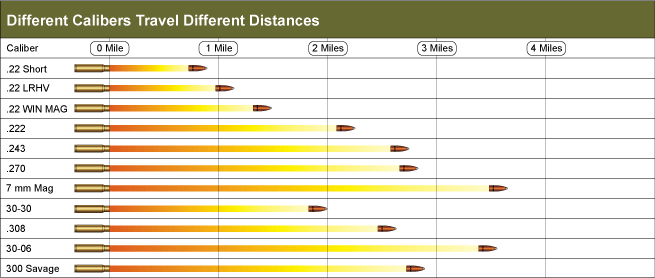How far will a 243 bullet travel? The maximum distance a .243 Winchester bullet can travel is approximately 5,000 yards, or nearly 3 miles, when fired at an optimal angle of elevation (around 30-45 degrees). However, it’s crucial to remember that shooting at such distances is extremely dangerous and unethical, and should only ever be considered in a controlled environment like a military proving ground. This guide provides details about factors affecting 243 bullet travel, 243 Winchester effective range, and 243 safe shooting distance.

Image Source: images.ctfassets.net
Factors Influencing 243 Bullet Travel Distance
Several elements dictate how far a .243 bullet will travel. These span from environmental conditions to the characteristics of the cartridge itself. These include:
- Bullet Weight and Design: Heavier bullets generally retain energy better and are less susceptible to wind drift. Bullet shape also affects its aerodynamic efficiency and ability to maintain velocity.
- Muzzle Velocity: The initial speed of the bullet significantly impacts its range. Higher muzzle velocities translate to greater distances.
- Angle of Elevation: The angle at which the rifle is fired relative to the horizontal plays a crucial role. An optimal angle will maximize distance.
- Air Resistance: Drag caused by air resistance constantly decelerates the bullet. This is affected by air density, humidity, and temperature.
- Wind: Wind speed and direction can drastically alter the bullet’s trajectory, especially at longer ranges.
- Gravity: Gravity pulls the bullet downwards, causing bullet drop that needs to be accounted for, especially at longer distances.
Understanding 243 External Ballistics
243 external ballistics is the study of the bullet’s behavior after it leaves the gun barrel. This encompasses aspects like:
- Trajectory: The curved path the bullet takes through the air.
- Bullet Drop: The amount the bullet falls below the line of sight at a given distance.
- Wind Drift: The lateral displacement of the bullet due to wind.
- Velocity: The speed of the bullet at different points in its flight.
- Energy: The kinetic energy the bullet possesses at different points in its flight.
These factors are interconnected. For example, a bullet with a high ballistic coefficient (BC) will experience less air resistance, retain its velocity better, and exhibit less bullet drop and wind drift.
Deciphering the 243 Ballistics Chart
A 243 ballistics chart is a table of data that shows how a bullet’s trajectory changes over distance. It typically includes information such as:
- Range (yards): The distance from the muzzle to the target.
- Velocity (fps): The speed of the bullet at that range.
- Energy (ft-lbs): The kinetic energy of the bullet at that range.
- Bullet Drop (inches): The amount the bullet falls below the line of sight.
- Wind Drift (inches): The amount the bullet is pushed sideways by a 10 mph wind.
Here’s an example of a simplified 243 ballistics chart using a 100-grain bullet with a ballistic coefficient of 0.400 and a muzzle velocity of 2960 fps, zeroed at 200 yards:
| Range (Yards) | Velocity (fps) | Energy (ft-lbs) | Bullet Drop (inches) | Wind Drift (inches) (10 mph) |
|---|---|---|---|---|
| 0 | 2960 | 1945 | -1.5 | 0 |
| 100 | 2764 | 1694 | 0.0 | 0.6 |
| 200 | 2576 | 1475 | 0.0 | 2.5 |
| 300 | 2395 | 1284 | -5.3 | 5.7 |
| 400 | 2221 | 1114 | -15.5 | 10.3 |
| 500 | 2054 | 966 | -31.5 | 16.2 |
Note: This is a simplified example. Actual ballistics data can vary based on the specific ammunition and environmental conditions.
You can use these charts to estimate bullet drop and wind drift at different ranges, which is essential for 243 long range shooting and ethical hunting.
Grasping 243 Winchester Effective Range
243 Winchester effective range differs from its maximum potential distance. Effective range is the distance at which the bullet still has enough energy to ethically and reliably take down a game animal, or accurately hit a target.
- Hunting: For deer-sized game, a .243 Winchester is typically considered effective out to around 300-400 yards. Beyond this, the bullet’s energy may be insufficient for a clean kill. Smaller game animals can be taken at slightly longer ranges.
- Target Shooting: For target shooting, the effective range depends on the shooter’s skill and the target size. Skilled shooters can achieve consistent accuracy out to 600 yards or more under ideal conditions.
243 Trajectory at Long Range
The 243 trajectory at long range becomes increasingly curved due to gravity and air resistance. This means the shooter must compensate for bullet drop by aiming higher than the target. This compensation increases dramatically as the range extends.
For example, using the ballistics chart above, at 500 yards, the bullet will drop 31.5 inches below the point of aim (when zeroed at 200 yards).
243 Bullet Drop
243 bullet drop is a critical factor in long-range shooting. As the bullet travels downrange, gravity continuously pulls it downwards, causing it to drop below the initial line of sight. The amount of drop increases with distance and is influenced by the bullet’s velocity, weight, and ballistic coefficient.
Here’s a table showcasing estimated bullet drop for a .243 Winchester using a 100-grain bullet with a muzzle velocity of 2960 fps and a 200-yard zero:
| Range (Yards) | Bullet Drop (Inches) |
|---|---|
| 100 | 0 |
| 200 | 0 |
| 300 | -5.3 |
| 400 | -15.5 |
| 500 | -31.5 |
This demonstrates the increasing need to account for bullet drop at longer ranges to ensure accurate shots.
Ethical 243 Hunting Distances
Ethical hunting dictates that you take shots only when you are confident of a clean and humane kill. This requires considering your skill level, the game animal’s size, and the .243 Winchester’s capabilities.
- Maximum Ethical Range: For deer-sized game, many hunters consider 300-400 yards to be the maximum ethical range for a .243 Winchester, provided they are skilled and practiced at those distances.
- Factors Affecting Ethical Range: Wind, terrain, the animal’s position, and the hunter’s shooting ability can all affect the ethical range.
- Importance of Shot Placement: Accurate shot placement is crucial, regardless of the distance. A well-placed shot in the vital organs will ensure a quick and humane kill.
243 Long Range Shooting: Considerations
243 long range shooting requires a thorough grasp of ballistics and external factors. Several skills and equipment are needed for consistent results:
- Accurate Rifle: A rifle with a consistent trigger pull and a stable platform.
- Quality Scope: A scope with adjustable turrets for elevation and windage is essential.
- Rangefinder: A rangefinder helps determine the exact distance to the target.
- Ballistic Calculator: These tools help predict bullet drop and wind drift based on specific ammunition and environmental conditions.
- Wind Meter: Measuring wind speed and direction is crucial for accurate shot placement.
- Practice: Regular practice at long ranges is essential to develop the skills necessary for accurate shooting.
Interpreting 243 Bullet Travel Time
243 bullet travel time refers to the duration a bullet spends in flight from the muzzle to the target. This is crucial in long-range shooting because the longer the bullet is in the air, the more it is affected by external factors like wind and gravity.
- Factors Influencing Travel Time: Muzzle velocity, bullet weight, and ballistic coefficient all impact travel time. Higher muzzle velocities and more aerodynamic bullets result in shorter travel times.
- Importance of Calculation: Knowing the travel time allows shooters to better estimate and compensate for wind drift and bullet drop.
- Example: A .243 bullet traveling to a target 500 yards away might have a travel time of approximately 0.7 to 0.8 seconds. During this time, even a slight breeze can significantly alter the bullet’s trajectory.
Emphasizing 243 Safe Shooting Distance
While the .243 Winchester bullet can travel a considerable distance, 243 safe shooting distance is paramount. This is the area where the bullet could potentially land, and safety protocols must always be observed.
- Understanding Maximum Range: Knowing that the bullet can travel up to 3 miles is crucial for identifying the potential hazard zone.
- Backstop: Always shoot with a safe and adequate backstop to prevent bullets from traveling beyond the target area. The backstop should be able to stop the bullet reliably.
- Awareness of Surroundings: Be aware of what lies beyond your target. Ensure there are no houses, roads, or other populated areas within the potential trajectory.
- Angle of Fire: Avoid shooting at high angles, as this increases the maximum range of the bullet.
- Local Laws and Regulations: Always comply with local laws and regulations regarding firearm use and shooting ranges.
Frequently Asked Questions (FAQ)
- What is the maximum range of a .243 Winchester?
- The maximum range of a .243 Winchester bullet is approximately 5,000 yards (nearly 3 miles). However, firing at such distances is incredibly dangerous and should only be done in controlled environments.
- What is the effective hunting range of a .243 for deer?
- The effective hunting range for deer-sized game is generally considered to be 300-400 yards, provided the shooter is skilled and practiced.
- How much does a .243 bullet drop at 300 yards?
- A .243 bullet can drop approximately 5-6 inches at 300 yards, depending on the load and zero distance. Refer to a ballistics chart for specific information.
- What is a good zero distance for a .243?
- A 200-yard zero is a common choice for .243 rifles used for hunting. This provides a relatively flat trajectory out to that distance.
- Can I use a .243 for long-range target shooting?
- Yes, a .243 can be used for long-range target shooting, but it requires skill, practice, and a thorough comprehension of ballistics. Skilled shooters can accurately engage targets out to 600 yards or more.
- What factors affect bullet travel time?
- Bullet travel time is influenced by muzzle velocity, bullet weight, and ballistic coefficient.
- Is a .243 suitable for all types of game?
- The .243 is generally considered suitable for small to medium-sized game like deer, antelope, and varmints. It’s not typically recommended for larger or dangerous game.
- What is the safest way to shoot a .243?
- Always shoot with a safe backstop, be aware of your surroundings, and comply with all local laws and regulations. Never shoot at high angles or without knowing what lies beyond your target.
- How does wind affect the .243 bullet trajectory?
- Wind can significantly affect the .243 bullet trajectory, causing wind drift. The amount of drift depends on the wind speed, bullet’s ballistic coefficient, and the distance to the target.
- What is a ballistic coefficient, and why is it important?
- The ballistic coefficient (BC) is a measure of a bullet’s ability to overcome air resistance. A higher BC indicates a more aerodynamic bullet that will retain velocity better and experience less drop and wind drift.

Hi, I’m Candace Wafford, a travel and food blogger based in Lexington, Kentucky. As a corporate traveler, I’ve had the chance to explore a lot of places, but now I’m on a mission to travel full-time. My goal? To figure out how to take my cat along for the adventure! Here at destinationdorworth.com, I share my experiences and tips on outdoor activities, travel, and of course, the best food spots I come across. I hope my blog inspires you to explore more and eat well on your journeys!
